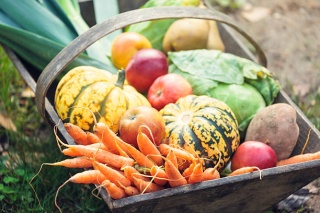By Sharita Jennings
GetFitLikeThat.com | Blackdoctor.org
As fall rolls in, your wardrobe isn’t the only thing you should switch up. Along with the longer sleeves, booties, and tights, have you added the hot new fruits and veggies to your shopping list? If not, then allow me to introduce you to seasonal eating. Seasonal eating is something that you might be doing without knowing. It’s basically eating produce that grows locally during the given season. We’re accustomed to eating whatever fruits and veggies we want year-round, but it turns out that in-season, local foods have the most vitamins and nutrients without the extra chemicals used to ship your food across the country.
The good news is that finding seasonal and local produce is getting easier thanks to farmer’s markets, produce delivery services, and our Forever First Lady, Michelle Obama, who made home gardens great again.
Health enthusiasts and advocates like Mrs. Obama agree that eating seasonal fruits and veggies can have positive effects on your health and your wallet.
For starters, seasonal eating cuts down on the distance that your food has to travel, so you get to enjoy your produce closer to its peak ripeness. This means you’ll get the maximum amount of nutrients from your fruits and veggies along with the purest taste that nature intended.
Eating with the seasons also means that fewer chemicals like pesticides can come in contact with your favorite fall foods, making them safer for you to eat than off-season produce.
As if you needed more reason to eat seasonally, in-season fruits and veggies are usually cheaper because the food is grown locally and has fewer transportation costs included in the price.
Now get out your grocery list and make sure you add some of my favorite fall foods to your list. Pro tip: If it’s on sale at the grocery store, it’s probably in season!
1. Brussels Sprouts
Brussels sprouts are in the same family as cabbage and broccoli so you know they are packing serious health benefits. Brussels sprouts are harvested in the fall so it’s the best time to take advantage of this huge source of vitamin C, iron, and even a bit of protein. One of the best ways to enjoy Brussels sprouts without cooking out all the nutrients is to lightly roast them in olive oil and garlic to keep the crunchiness with a bit of added flavor.
2. Pumpkins
These are definitely the classic for the fall, and they can do more than just spice up your lattes and muffins. Pumpkins are packed with cancer-fighting antioxidants and weight-busting fiber, for a small number of calories. There are plenty of ways to take advantage of the pumpkin goodness — you can puree it, stew it or bake it into your favorite recipe, or just eat the seeds for a high-fiber snack that won’t ruin your diet.
3. Apples While apples are known for being healthy and keeping doctors away, they have gained a bad rep over recent years for the high amount of pesticides used to harvest them year-round. The good news is that far fewer chemicals are used on apples that are bought in-season, which is typically fall and winter.
4. Pears
For some strange reason, pears never seem to top the lists of people’s favorite fruits, but these flavorful treats shine during the fall season. Like apples, pear skins are full of soluble fiber, which has been shown to help reduce bad cholesterol levels.
Plus, pears are packed with vitamins C, K, and B which can give you an energy boost. You’ll also get in calcium, magnesium and potassium, which can help to strengthen your immune system for the colder months. During the fall, look for Bosc and Bartlett pears, which are in season in the U.S. You can eat them alone or add them to a smoothie for a twist.
5. Turnips & Rutabagas
If you have a southern grandmother, then you probably know all about turnip greens. These leafy veggies thrive in the fall season, along with the turnip itself. Eating turnips and their veggie cousins rutabagas have been shown to help reduce people’s risk for prostate and lung cancer thanks to their hearty amounts of vitamins A and C. Eating the leafy turnip greens can also boost bone health thanks to calcium and heart health because of Vitamin K. You can try roasting or stewing the turnips themselves, and slow cooking the greens to warm up during the chilling months.

